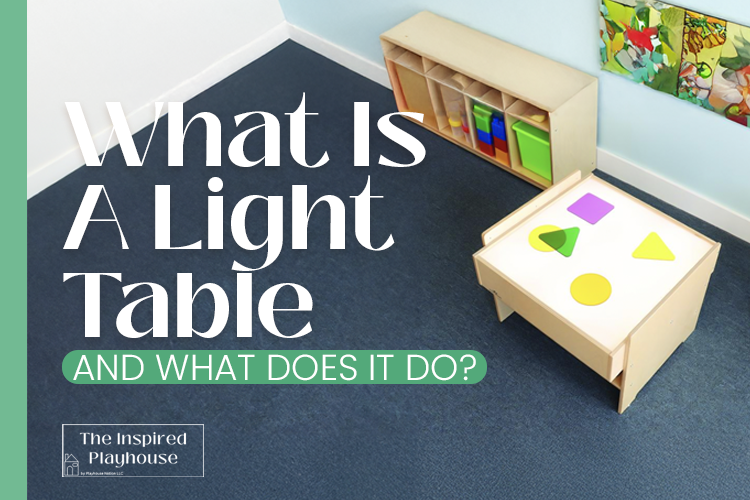A light table is a versatile piece that serves as both functional furniture and provides hours of learning and fun. It’s perfect for helping your child explore and work with translucent materials in an interactive and engaging way. But what exactly is a light-up table, and how can it benefit your child’s learning experience?
This article will discuss the purpose of a light table and its advantages. You will also learn how to choose the perfect one for your child.
Understanding Light-up Tables for Kids
Light tables encourage creativity and sensory play in kids. These tables have an illuminated surface that highlights translucent materials. This makes it easy to explore:
- Shapes
- Colors
- Patterns
Light tables are popular in early childhood education classrooms as well as playrooms. By making learning visual and tactile, they teach:
- Color concepts
- Geometry
- Basic literacy
Benefits of Using a Light Table
Here’s a look at the key benefits of using a light table and how it can support different aspects of a child's growth.
Supports All Styles of Learning
Each child learns differently, and light tables accommodates different styles and temperaments. Light tables engage all types of learners, whether your child prefers colors and patterns or tactile activities. This versatile tool can be customized to your child's learning style, making it a great addition to your home and classrooms.
Builds Fine Motor Skills
Light table helps improve your child's fine motor skills. As kids trace shapes, arrange things, or draw on paper on the lit surface, they develop mastery of fine motor skills. Drawing a circle or star is entertaining, but it also strengthens hands and fingers. These activities gradually develop hand-eye coordination and prepare them for harder tasks.
Encourages Creativity and Imagination
Light tables can inspire creativity in your children. The way light interacts with colored paper or transparent shapes inspires kids to create. They can layer colors to create new images, arrange objects to tell a story, or build a scene.
This play encourages creative thinking and hands-on imagination. Plus, watching their inventions come to life with light keeps children curious and eager to explore.
Boosts Problem-Solving Skills
Light tables also encourage kids to problem-solve. Children regularly face small obstacles that require critical thinking. They use logic and spatial awareness by arranging shapes to produce a pattern or experimenting with colors and materials. Trial and error builds confidence and persistence as your kids solve problems on their own.
Develops Social Skills
Light tables are suitable for solo play and social skills-building group activities. Children learn how to share, wait their turn, and talk about their thoughts when they work together. These activities can teach them the importance of teamwork and cooperation. Having these social skills is important in your child’s school and life.
Light Table Activities for Kids
You can maximize your child's experience with these fun activities.
Drawing

Drawing on a light table is a unique experience for kids. The lit surface brings their works to life, improving the activity's enjoyment. Give your child translucent markers or dry-erase pens to use on the light-up table.
For younger children learning to sketch, the light beneath helps them see their lines better—a simple but efficient approach to inspiring art to your child.
Painting

Painting can be messy, but a light table makes it more fun. Clear plastic sheets can be used to paint on these tables. After painting the sheets, your child can set them on the table to examine how the colors reflect light.
With this strategy, your kids can experiment with color mixing and layering. The plastic sheet can be wiped down after use to prepare for the next masterpiece.
Tracing

Tracing is another great light table activity. Thanks to the steady light source under the paper, kids can see and follow the image they're tracing. This activity improves hand-eye coordination and fine motor abilities.
You can give your child animal, letter, or shape images to trace. Tracing builds confidence and control for writing and accurate drawing. It calms them and helps them focus and be patient.
Shaving Cream Writing

Writing with shaving cream on a light table is a fun and educational activity. The glowing surface under the shaving cream helps kids see their letters and shapes, which is beneficial for beginners.
Your children can practice letter recognition and fine motor skills by tracing letters and numbers in shaving foam. Kids who like hands-on learning like this activity's sensory aspect. The shaving cream wipes off easily, making the surface ready for the next activity.
Playing with Water Balloon

Besides outdoor play, water balloons can be used on a light-up table for sensory activity. Your children can experiment with light and color by filling little balloons with water and placing them on the table.
Bright light from water-filled balloons can captivate children and stir their interest. Kids can play with light refraction using water and see how different balloon colors interact with the light from the table.
Observing Nature Items

A light table can reveal new things about everyday objects. Putting leaves, flowers, or feathers on the glowing table helps kids see them differently. The light highlights leaf veins and feather structures that are hard to notice.
This practice encourages curiosity and nature appreciation. It also teaches basic science concepts like plant structure and light-material interactions.
Playing with Contact Paper Collages

Light-up tables with contact paper collages for a fun and mess-free activity. You can place a sticky-side-up contact paper on the luminous table and give your child translucent objects like:
- Colored tissue paper
- Cellophane
- Small leaves and petals
The light shines through the contact paper, creating a vivid, glowing mosaic. This project lets kids engage with composition and color and be creative. Additionally, the sticky contact paper makes it easy for young hands to position and move pieces without frustration.
Playing with Magna-Tiles

Using Magna-Tiles on a light-up table makes them more fun. Kids may link translucent magnetic tiles on an illuminated surface to make structures that light up. The light enhances colors and helps kids see tile connections.
This can help them understand spatial relationships and geometry. Magna-Tiles on a glowing table inspire problem-solving and critical thinking as kids experiment with shapes and structures. Learning about balance, symmetry, and design while playing is fun.
Playing with Water Beads

Water beads are another light-up table-friendly sensory play. Water-absorbing polymer beads sparkle like jewels on a light-up table. Kids can run their hands through the beads, scoop them up, or arrange them in designs while the light stimulates them visually.
This activity improves sensory awareness and fine motor skills. Its pleasant, relaxing feeling makes it ideal for unwinding after a long day.
Factors to Consider When Choosing a Light-up Table
When selecting a light-up table for your child, there are several important factors to keep in mind. This decision can impact how much your child enjoys and benefits from the table, so it’s worth taking the time to consider the following aspects.
Size and Space
The light-up table's size should be considered initially. Small tables fit on desks, but larger ones need space. You should also consider the surface area—more space allows your child to spread out things and pursue different activities.
If you have limited space, look for a table that folds up. Slim, lightweight tables can fit beneath a bed or in a closet. If you have a designated play or learning area, you can select a larger, more permanent setup. The idea is to fit this table into your child's space without cluttering or tripping.
Accessibility
If small children or special needs children will use the table, accessibility is also important. Keep the light-up table at a comfortable height for your child. Light-up tables with adjustable legs or floor use are more accessible for children of all ages and abilities.
Also, consider how easy it is for your child to turn the table on and off or change the lights. Younger users like tables with easy controls.
Safety
Safety should always come first, especially when buying products for kids. Choose solid, non-toxic light-up tables. The surface should be durable and have smooth edges to prevent injury. If the table will be used in a classroom or by numerous children, make sure its surface is shatterproof.
Also, keep the table's electrical components protected and cool during use. Before buying, check the product details, as many high-quality tables have safety features.
Versatility and Mobility
A multifunction light-up table is a good purchase. Tables with adjustable light settings let your child change the brightness or color for different tasks.
Also, consider how portable the table is. Portable tables are great for home and school use since they may be moved around the house or used outdoors. Versatility and mobility are important if your child uses the table for different activities.
Quality and Durability
Finally, if you want the light-up table to survive for years, quality and durability are important. High-quality tables can survive daily use. Durable light sources like LEDs are popular due to their extended lifespan and energy efficiency.
Check reviews or ask for advice on getting a durable, well-made table. A sturdy, light-up table is a great investment and safer for your child.
Get a Light Table for Your Child Today!
If you’re looking for a tool that’s both fun and educational, a light-up table might be the perfect investment. It keeps your child entertained while also supporting their learning and creativity in a hands-on, engaging way. Your kids can create their artwork while developing important skills like hand-eye coordination and fine motor control.
So, check out the best light table today and keep kids entertained for hours!

